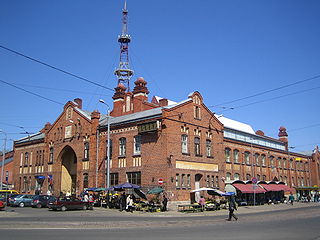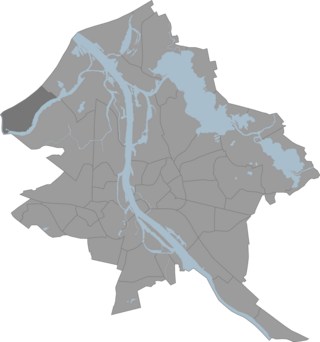
Jūrmala is a state city in Latvia, about 25 kilometres west of Riga. Jūrmala is a resort town stretching 32 km and sandwiched between the Gulf of Riga and the Lielupe River. It has a 33 km stretch of white-sand beach and is the fifth-largest city in Latvia.

Riga District was an administrative division of Latvia, located in Semigallia and Vidzeme regions, in the centre of the country. The district had the two cities of Riga and Jūrmala with the Gulf of Riga to the north. Beginning from the west and counterclockwise to the east, Riga District had Tukums, Jelgava, Bauska, Ogre, Cēsis and Limbaži former districts as neighbours. The area of the district was 3,058 km² with a population of 159,247.

Salaspils is a town in Latvia, the administrative centre of Salaspils Municipality. The town is situated on the northern bank of the Daugava river, 18 kilometers to the south-east of the city of Riga.

Saulkrasti is a town in Latvia on the east coast of the Gulf of Riga and the capital of the Saulkrasti municipality. Made up of a number of historic fishing settlements, the town stretches for some 17 km from the Inčupe river in the south to the village of Skulte in the north. The town itself spans across 4.8 square kilometres (1.9 sq mi) and includes an additional 42 square kilometres (16 sq mi) of fields and forests.

Purvciems is a neighbourhood in the Vidzeme Suburb of Riga, Latvia. Its name literally translates as "marsh village". It is located on the east bank of the River Daugava, to the east of the City Centre and is defined roughly as the area between A. Deglava Iela and Ieriķu Iela. The area is characterised by apartment blocks from the late Soviet and the first years after the restoration of Latvian independence (1980s–1990s), though there is also some detached housing. The district is Latvian and Russian-speaking.

Mežaparks is a neighbourhood of Northern District in Riga, the capital of Latvia. It consists of a residential area to the South and a large urban park to the North of the same name – Mežaparks. The neighbourhood is located on the western shore of Lake Ķīšezers. The name is literally translated as "forest park". The neighbourhood and park were built in the early 20th century and the area was originally called Kaiserwald. It was one of the world's first garden cities. It had large number of Art Nouveau and Eclectic villas for upper class inhabitants of Riga. During the Second World War, the Kaiserwald concentration camp was located in this park, and many Jews, Gypsies, Communists, and other opponents of Nazi rule were murdered in these woods.

Āgenskalns is a district in Riga, located on the left bank of the Daugava, an old neighbourhood, mainly built in the late 19th to early 20th century. The total area of Āgenskalns is 4,6 km2, which is a lot less than other districts of Riga.

Riga Central Market is Europe's largest market and bazaar in Riga, Latvia. It is one of the most notable structures from 20th century in Latvia and has been included in UNESCO World Heritage Site list together with Old Riga in 1998. It was planned from 1922 and built from 1924 to 1930. The main structures of the market are five pavilions constructed by reusing old German Zeppelin hangars and incorporating Neoclassicism and Art Deco styles. The market is 72,300 square metres (778,000 sq ft) wide with more than 3,000 trade stands.

Riga Zoo is a city-owned zoo in Riga, Latvia. It is located in Mežaparks neighbourhood next to the Mežaparks park, on the western bank of Ķīšezers lake. Riga Zoo houses around 4000 animals of nearly 500 species and is visited by 250–300,000 visitors annually. The zoo has a branch "Cīruļi" in Liepāja District, Kalvene parish, established in 1996, it has an area of 135 hectares.

Madona Municipality is a municipality in Vidzeme, Latvia. The administrative center is Madona.

Buļļi or Rītabuļļi is a neighbourhood of Riga, the capital of Latvia. The Western area is known as Vakarbuļļi.

Skanste is a neighbourhood located in the center of Riga, the capital of Latvia, and is currently becoming the most modern part of Riga. Geographically, the neighborhood is situated in the northern part of the railway ring on the right bank of the Daugava, bordering the Sarkandaugava, Brasa, Centrs, and Pētersala-Andrejsala neighborhoods.

The Mežaparks Great Bandstand, also called the Song Festival Bandstand, Open-Air Stage, is a large open-air bandstand in Mežaparks park in the Mežaparks neighbourhood of Riga, the capital of Latvia. The bandstand has added cultural value to Riga since 1955, when the Latvian Song and Dance Festival was moved to this venue.

Forest Cemetery is an 85 hectares large cemetery in the northwestern part of Riga, the capital of Latvia, between the neighbourhoods of Mežaparks and Čiekurkalns. Formally, the cemetery is divided between 1st Forest Cemetery, with entrance from Aizsaules Street, and 2nd Forest Cemetery, with entrance from Gaujas Street.

Bastejkalns Park is a spacious park on the eastern edge of the old town of Latvian capital Riga.
Kristaps Gulbis is a Latvian sculptor and artist known for numerous contemporary art projects in more than 25 countries. His works have been exhibited at the Venice Biennale, the Museum of Modern Art in Hokaido, Japan, and at metropolitan sites in London, Paris, Rome, Berlin, Riga, Moscow and other European cities, as well as in New York, Seoul, and Kaohsiung, Taiwan. The visual art projects curated, directed and managed by Gulbis have been set in England, Hungary, Germany, Latvia, Estonia and elsewhere in Europe.

Dabas parks Piejūra is a nature park along the Gulf of Riga in Latvia founded in 1962. It is a protected nature reserve and a Natura 2000 location. The park stretches 36.6 kilometres (22.7 mi) over an 4,180 hectares area from Riga, through Carnikava Municipality, and up to Saulkrasti. It is a popular seasonal recreation location, notably for beach access. The park is notable for its protected biotopes, particularly its dunes and boreal forests. The park's conservation plan for 2020 onwards was developed under the "LIFE CoHaBit" project.

Augšdaugava Municipality is one of the 35 municipalities established in Latvia in 2021. It surrounds the independent city of Daugavpils and its municipal headquarters are located there. Its first elected municipal council has taken office on 1 July 2021.

Gaizinkalns Nature Park is located in Latvia in Madona Municipality Vestienas, Aronas and Bērzaunes parishes, Natura 2000 territory. The territory of the park covers Vidzeme Uplands around Gaizinkalns, Lake Talejas and Viešūrs, as well as several small lakes. Here is the highest place in Latvia - Gaizinkalns - 311.94 m.






















